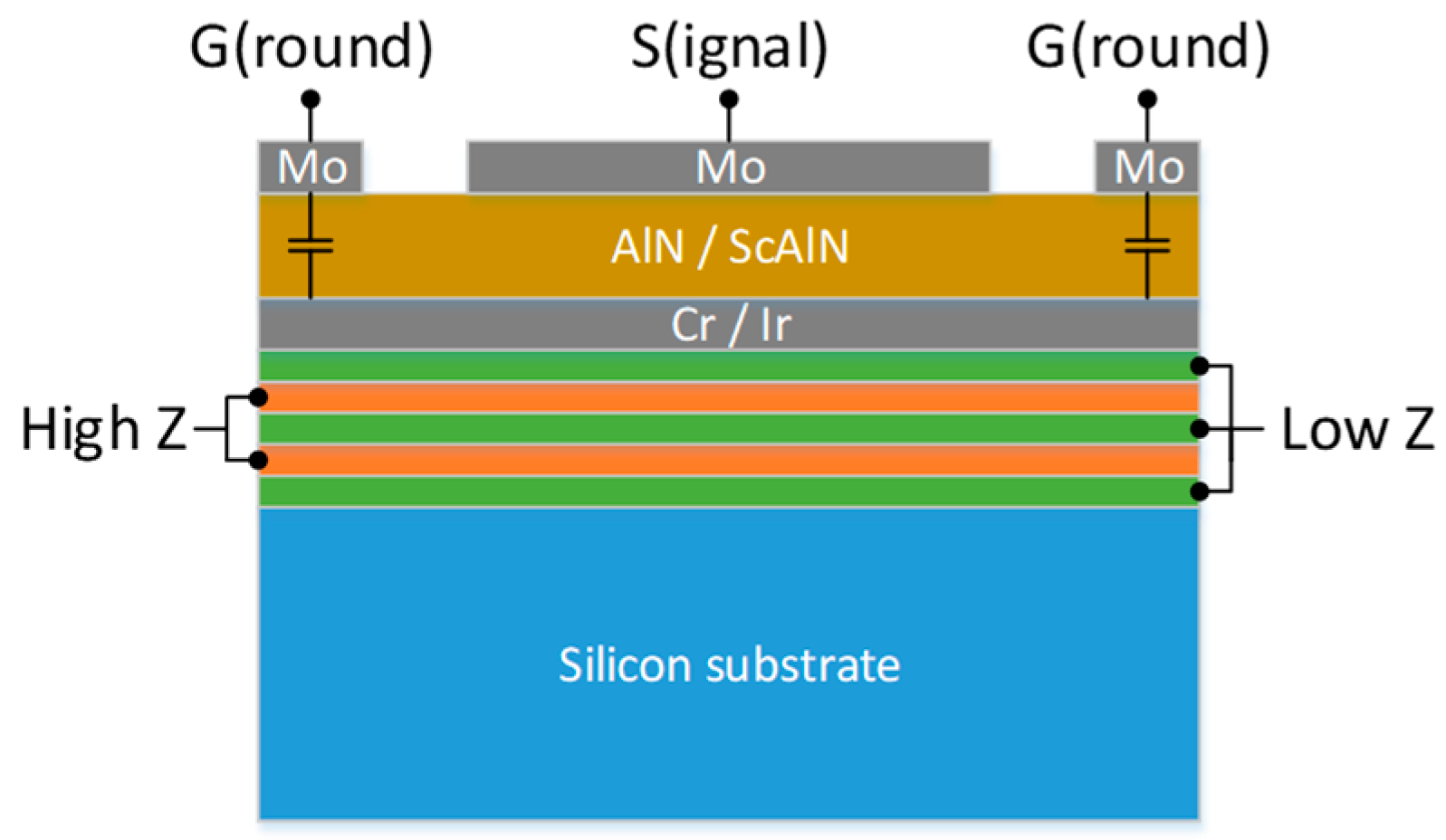Scandium Aluminium Nitride-Based Film Bulk Acoustic Resonators †
Abstract
:1. Introduction
2. Materials and Methods
3. Results and Discussion
4. Conclusions
Acknowledgments
Conflicts of Interest
References
- Ruby, R. Review and Comparison of Bulk Acoustic Wave FBAR, SMR Technology. In Proceedings of the IEEE Ultrasonics Symposium, New York, NY, USA, 28–31 October 2007; pp. 1029–1040. [Google Scholar]
- Ruby, R. A Snapshot in Time: The Future in Filters for Cell Phones. IEEE Microw. Mag. 2015, 16, 46–59. [Google Scholar] [CrossRef]
- Cannatà, D.; Benetti, M.; Verona, E.; Varriale, A.; Staiano, M.; Auria, S.D.; Pietrantonio, F.D. Odorant detection via Solidly Mounted Resonator biosensor. In Proceedings of the IEEE International Ultrasonics Symposium, Dresden, Germany, 7–10 October 2012; pp. 1537–1540. [Google Scholar]
- Hoffmann, R.; Schreiter, M.; Heitmann, J. The concept of thin film bulk acoustic resonators as selective CO2 gas sensors. J. Sens. Sens. Syst. 2017, 6, 87–96. [Google Scholar] [CrossRef]
- Chen, Y.C.; Shih, W.C.; Chang, W.T.; Yang, C.H.; Kao, K.S.; Cheng, C.C. Biosensor for human IgE detection using shear-mode FBAR devices. Nanoscale Res. Lett. 2015, 10, 69. [Google Scholar] [CrossRef] [PubMed]
- Chen, D.; Wang, J.; Xu, Y.; Li, D.; Zhang, L.; Li, Z. Highly sensitive detection of organophosphorus pesticides by acetylcholinesterase-coated thin film bulk acoustic resonator mass-loading sensor. Biosens. Bioelectron. 2013, 41, 163–167. [Google Scholar] [CrossRef] [PubMed]
- DeMiguel-Ramos, M.; Díaz-Durán, B.; Escolano, J.M.; Barba, M.; Mirea, T.; Olivares, J.; Clement, M.; Iborra, E. Gravimetric biosensor based on a 1.3 GHz AlN shear-mode solidly mounted resonator. Sens. Actuators B Chem. 2017, 239, 1282–1288. [Google Scholar] [CrossRef]
- Trolier-McKinstry, S.; Muralt, P. Thin Film Piezoelectrics for MEMS. J. Electroceram. 2004, 12, 7–17. [Google Scholar] [CrossRef]
- Wang, Q.; Lu, Y.; Mishin, S.; Oshmyansky, Y.; Horsley, D.A. Design, Fabrication, and Characterization of Scandium Aluminum Nitride-Based Piezoelectric Micromachined Ultrasonic Transducers. J. Microelectromech. Syst. 2017, 26, 1132–1139. [Google Scholar] [CrossRef]
- Teshigahara, A.; Hashimoto, K.Y.; Akiyama, M. Scandium aluminum nitride: Highly piezoelectric thin film for RF SAW devices in multi GHz range. In Proceedings of the IEEE International Ultrasonics Symposium, Dresden, Germany, 7–10 October 2012; pp. 1–5. [Google Scholar]
- Mayrhofer, P.M.; Rehlendt, C.; Fischeneder, M.; Kucera, M.; Wistrela, E.; Bittner, A.; Schmid, U. ScAlN MEMS Cantilevers for Vibrational Energy Harvesting Purposes. J. Microelectromech. Syst. 2017, 26, 102–112. [Google Scholar] [CrossRef]
- DeMiguel-Ramos, M.; Mirea, T.; Olivares, J.; Clement, M.; Sangrador, J.; Iborra, E. Assessment of the shear acoustic velocities in the different materials composing a high frequency solidly mounted resonator. Ultrasonics 2015, 62, 195–199. [Google Scholar] [CrossRef] [PubMed]
- Schneider, M.; Bittner, A.; Schmid, U. Improved piezoelectric constants of sputtered aluminium nitride thin films by pre-conditioning of the silicon surface. J. Phys. D Appl. Phys. 2015, 48. [Google Scholar] [CrossRef]
- Mayrhofer, P.M.; Euchner, H.; Bittner, A.; Schmid, U. Circular test structure for the determination of piezoelectric constants of ScxAl1-xN thin films applying Laser Doppler Vibrometry and FEM simulations. Sens. Actuators A Phys. 2015, 222, 301–308. [Google Scholar] [CrossRef] [PubMed]
- Olivares, J.; Wegmann, E.; Clement, M.; Capilla, J.; Iborra, E.; Sangrador, J. Assessment of solidly mounted resonators with wide-band asymmetric acoustic reflectors. In Proceedings of the IEEE International Ultrasonics Symposium, San Diego, CA, USA, 11–14 October 2010; pp. 1677–1680. [Google Scholar]


| Device | |||||
|---|---|---|---|---|---|
| ScAlN, a6 | 2.123 | 2.231 | 101.1 | 158.1 | 11.37 |
| ScAlN, a7 | 2.109 | 2.225 | 96.3 | 178.8 | 12.18 |
| ScAlN, a9 | 2.098 | 2.206 | 109.2 | 173.4 | 11.49 |
| AlN, a1 | 2.5 | 2.528 | 300.6 | 559.6 | 2.71 |
| AlN, a6 | 2.509 | 2.542 | 261.6 | 346 | 3.14 |
| Area [µm²] | |||||
|---|---|---|---|---|---|
| 15,200 | 2.123 | 2.231 | 101.1 | 158.1 | 11.37 |
| 25,200 | 2.141 | 2.245 | 87.9 | 162.5 | 10.99 |
| 37,700 | 2.183 | 2.281 | 128.6 | 280 | 10.2 |
| 55,200 | 2.156 | 2.263 | 92.4 | 213.2 | 11.06 |
Publisher’s Note: MDPI stays neutral with regard to jurisdictional claims in published maps and institutional affiliations. |
© 2017 by the authors. Licensee MDPI, Basel, Switzerland. This article is an open access article distributed under the terms and conditions of the Creative Commons Attribution (CC BY) license (https://creativecommons.org/licenses/by/4.0/).
Share and Cite
Schneider, M.; DeMiguel-Ramos, M.; Flewitt, A.J.; Iborra, E.; Schmid, U. Scandium Aluminium Nitride-Based Film Bulk Acoustic Resonators. Proceedings 2017, 1, 305. https://doi.org/10.3390/proceedings1040305
Schneider M, DeMiguel-Ramos M, Flewitt AJ, Iborra E, Schmid U. Scandium Aluminium Nitride-Based Film Bulk Acoustic Resonators. Proceedings. 2017; 1(4):305. https://doi.org/10.3390/proceedings1040305
Chicago/Turabian StyleSchneider, Michael, Mario DeMiguel-Ramos, Andrew J. Flewitt, Enrique Iborra, and Ulrich Schmid. 2017. "Scandium Aluminium Nitride-Based Film Bulk Acoustic Resonators" Proceedings 1, no. 4: 305. https://doi.org/10.3390/proceedings1040305





